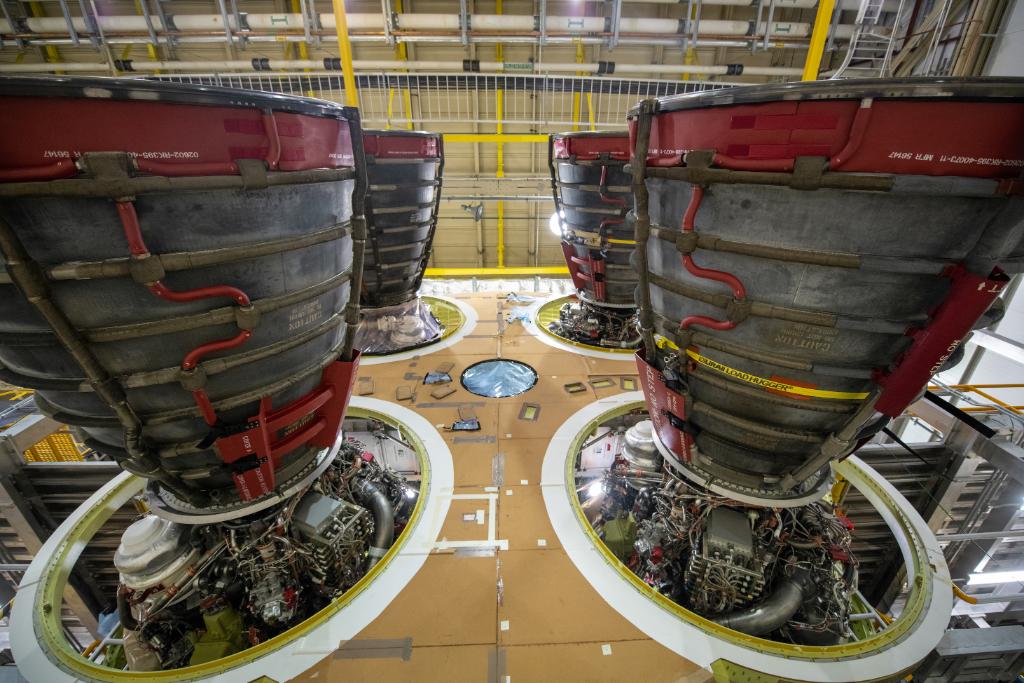NASA orders 18 more engines for its Space Launch System megarocket

NASA has ordered 18 more rocket engines for its new Space Launch System megarocket for future Artemis moon missions.
The new order, valued at $1.79 billion, calls for the California-based aerospace company Aerojet Rocketdyne to provide 18 RS-25 engines to power future SLS rockets. The agreement builds upon an existing deal between NASA and Aerojet for six SLS engines. This new order boosts the final contract's value to about $3.5 billion through 2029, NASA officials said.
"This contract allows NASA to work with Aerojet Rocketdyne to build the rocket engines needed for future missions," NASA SLS program manager John Honeycutt at the agency's Marshall Space Flight Center in Huntsville, Alabama said in a statement.
Related: How NASA's Space Launch System will work (infographic)
Each SLS rocket will use four RS-25 rocket engines to launch its 212-foot (65-meter) core stage. The rocket will also use two strap-on solid rocket boosters and an upper stage to launch NASA's Orion crew capsule. The Artemis program will use SLS and Orion to return astronauts to the moon by 2024.
NASA currently has 16 of the engines (salvaged from the agency's now-retired space shuttle program) that will be used on the first four SLS rocket launches for Artemis missions 1 through 4. Those engines will cover Artemis flights through the program's first crewed moon landing (Artemis 3) and a follow-up flight.
NASA's Artemis 1 mission is expected to launch in 2021. The engines for that flight are installed on an SLS core stage and awaiting a major test at NASA's Stennis Space Center in Mississippi. That work has been on hold since March due to the ongoing coronavirus pandemic.
Get the Space.com Newsletter
Breaking space news, the latest updates on rocket launches, skywatching events and more!
The new agreement with Aerojet Rocketdyne will add another 24 SLS engines for the Artemis program, enough for another six flights.
"We've already begun production on the first six new RS-25 engines," SLS engines manager Johnny Heflin said in the same statement. "Aerojet Rocketdyne has restarted the production lines, established a supplier base and is building engines using advanced techniques that reduce both the cost and time for manufacturing each engine."
The SLS rocket's four RS-25 engines provide a total of 2 million lbs. of thrust during launch to carry an Orion capsule into orbit. The engines left over from the space shuttle program have been overhauled with new computer controllers and upgraded to ensure they can handle the higher performance demands of an SLS launch, NASA officials have said.
- Watch NASA's SLS megarocket get ready for new US moon missions (video)
- NASA needs to put a price on Artemis to gain support from Congress
- Europa mission shouldn't be shackled to SLS megarocket, NASA OIG says
Email Tariq Malik at tmalik@space.com or follow him @tariqjmalik. Follow us @Spacedotcom, Facebook and Instagram.
OFFER: Save 45% on 'All About Space' 'How it Works' and 'All About History'!
For a limited time, you can take out a digital subscription to any of our best-selling science magazines for just $2.38 per month, or 45% off the standard price for the first three months.
Join our Space Forums to keep talking space on the latest missions, night sky and more! And if you have a news tip, correction or comment, let us know at: community@space.com.

Tariq is the Editor-in-Chief of Space.com and joined the team in 2001, first as an intern and staff writer, and later as an editor. He covers human spaceflight, exploration and space science, as well as skywatching and entertainment. He became Space.com's Managing Editor in 2009 and Editor-in-Chief in 2019. Before joining Space.com, Tariq was a staff reporter for The Los Angeles Times covering education and city beats in La Habra, Fullerton and Huntington Beach. In October 2022, Tariq received the Harry Kolcum Award for excellence in space reporting from the National Space Club Florida Committee. He is also an Eagle Scout (yes, he has the Space Exploration merit badge) and went to Space Camp four times as a kid and a fifth time as an adult. He has journalism degrees from the University of Southern California and New York University. You can find Tariq at Space.com and as the co-host to the This Week In Space podcast with space historian Rod Pyle on the TWiT network. To see his latest project, you can follow Tariq on Twitter @tariqjmalik.
-
Anjisan63 Awesome! At only $146 Million per rocket, I'm really looking forward to their One-Time use and disposal into the ocean after it flies once. What a DEAL for us US Taxpayers!Reply -
shellyhe I said it many months ago. the SLS rocket is enormously expensive with constant cost overruns and delays. Can't we trust our commercial partners by now? They have military contracts these days. I know that SpaceX flies their payloads regularly.Reply
NASA: Please don't order or build more engines or other parts anymore. Leave everything for the commercial guys. They will have the moon rockets up faster, safer and cheaper. Sell off the existing inventory. Please spend your money wiser. Please save the tax payers now and use that money for something that is needed today. We all know what that is. -
Lovethrust Can’t wait for that monster to fly, it’s going to open up the outer solar system for large craft.Reply -
Ebonheart it's really time to move NASA contracts to Fixed-Price Structure. NASA isn't an endless pile of money.Reply -
Anjisan63 I think Space.com should start adding these adjectives to any article that discusses rockets or rocket engines: Reusable / Disposable.Reply
So many countries end entities are now building reusable rockets. I think it would be awesome of Space.com to recognize this very distinctive difference in rocket functionality and the impact this functionality has on the overall costs.










